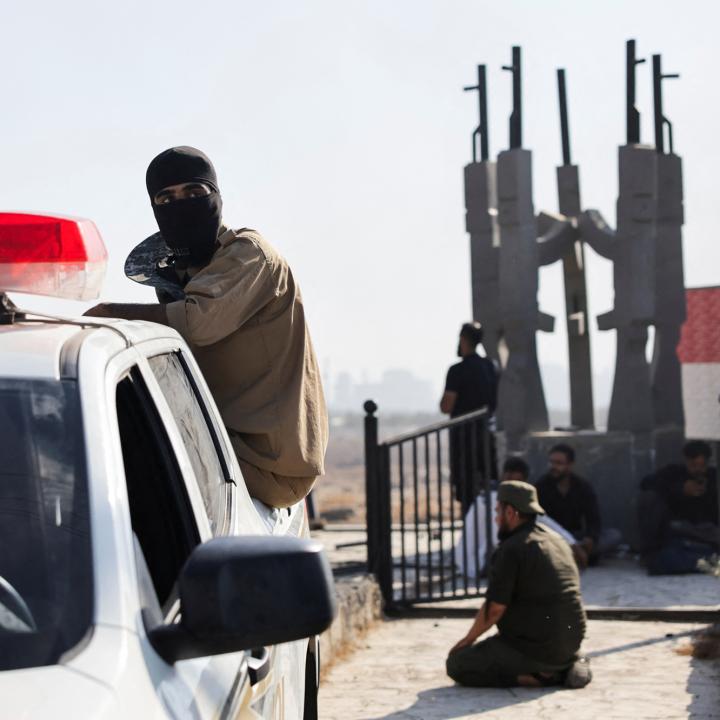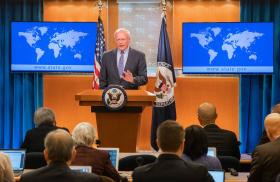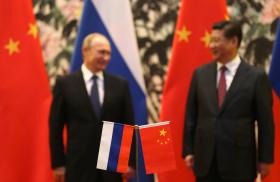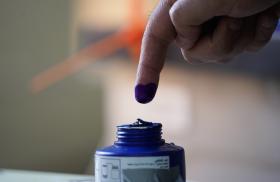
- Policy Analysis
- PolicyWatch 4081
Making Sure Damascus Learns the Right Lessons from the Suwayda Clashes

The deep problems within the transitional government’s security ranks have once again been tragically exposed, so the Trump administration should increase pressure on the foreign fighter issue and related matters—for the sake of Syria’s minorities and U.S. regional interests alike.
Sparked by a Bedouin ambush against a Druze vegetable seller, major armed clashes broke out in Syria’s southern Suwayda province on July 13. Since then, chaos has ensued, with newly deployed government forces reportedly committing serious human rights violations, Israel launching fresh airstrikes—including right on the new government’s doorstep in Damascus—and U.S. officials scrambling to calm the situation amid conflicting accounts about what is actually happening on the ground. Although a tenuous ceasefire is now in place, the crisis has put a brighter spotlight on well-known concerns about Syria’s sectarian landscape post-Assad and the new government’s ability to safely handle the transition. To find a diplomatic path out of the bloodshed, Washington will need to increase the pressure for accountability in Damascus—while keeping Israeli enforcement options open in the meantime.
Why Did the South Erupt?
When the initial fighting broke out, President Ahmed al-Sharaa deployed forces in the name of restoring order, protecting residents, and bringing the long-autonomous Druze-majority province under central government control. Instead, some of these forces were soon accused of committing field executions, rape, arson, looting, and other crimes and forms of humiliation. In response, Israel launched airstrikes against Syrian units in the south and the Defense Ministry’s headquarters in Damascus, mainly to address Israeli Druze fears about atrocities against their brethren next door.
By July 16, Washington had helped negotiate dual ceasefires—Israeli-Syrian and Druze-Damascus—while government forces had exited Suwayda. A day later, however, Druze retribution killings spurred the Bedouin—who were not party to the ceasefire—to deploy thousands of tribal fighters to Suwayda. Israel then announced it would allow government forces “limited entry” for forty-eight hours to separate the Druze and Bedouin. As of this writing, the ceasefire is back in place and government forces have withdrawn once again.
Druze tensions with the post-Assad authorities are nothing new. Previous clashes occurred in April and May, driven by Druze concerns over a host of issues that predate the civil war. The most persistent concerns include the lack of minority protections in the constitution, the state’s attempts to deploy outside forces to a province that has been controlled by Druze militias for over a decade, and the role of Sunni Islamist elements in the new Syria—particularly Hayat Tahrir al-Sham (HTS), Sharaa’s former jihadist group whose members now serve as the core of the new government and military.
Indeed, the latest clashes demonstrate that Damascus remains unwilling or unable to control its forces, particularly when deploying to minority-dominated areas. The government has seemingly not learned from the March coastal clashes in which more than 1,500 people were killed (see below). Most important, reports from Suwayda indicate that the government is still using foreign fighters in its ranks, despite the Trump administration’s exhortations to prioritize their removal.
Besides stoking sectarian strife that could plunge the country back into civil war, the new clashes will greatly complicate further U.S.-sponsored disengagement negotiations between Syria and Israel, as well as the central government’s ongoing integration talks with the Kurdish-dominated Syrian Democratic Forces (SDF), who have proven so crucial to fighting the Islamic State (IS) and securing detention facilities in the northeast. Learning the right lessons from Suwayda will be key to fulfilling President Trump’s commerce-focused goal of helping the new Syria “shine.” After extending the sanctions-lifting carrot up front while insisting that there is “no plan B” to working with Sharaa’s government, the administration needs to press him on immediately addressing the radicalization and lack of discipline exhibited by the Defense Ministry and security forces.
A Troubling Sectarian Pattern
Since the collapse of the minority-dominated Assad regime, questions have lingered about how the former leaders of a Sunni jihadist organization like HTS could rule a multi-confessional society where over a quarter of the population consists of minorities (Druze, Alawites, Shia, Ismailis, and Christians), and where the Sunni majority is highly differentiated by region and ethnicity (e.g., the Kurdish-controlled northeast). At first, many analysts noted the pragmatism and political acumen that Sharaa and his circle had shown in dealing with such issues inside their Idlib stronghold during the last years of the Assad era—an assessment that was initially supported by the lack of large-scale minority massacres in HTS-controlled areas during the regime’s collapse. Yet the post-Assad honeymoon was brief, and sectarian problems are growing rather than abating.
In early March, regime remnants attacked Sharaa’s forces in the Alawite-dominated Syrian coastal region, a longtime Assad stronghold. To put down this insurgency, the government deployed units that included substantial numbers of foreign fighters, some of whom reportedly committed gruesome acts against civilians along the coast and further inland near Hama. Government forces remain in control of the area today, and their hybrid nature has caused considerable local concern despite Damascus asking non-Sunnis to join their ranks.
In response to what have become known in Syria as the “coastal events,” Sharaa announced a four-month independent investigation and committed to hold the perpetrators accountable. The findings were submitted to him on July 12, the day before the Suwayda clashes broke out; he has not yet indicated when the report will be released publicly.
Elsewhere, clashes broke out between April 28 and May 4 when an allegedly fake social media clip of a Druze cleric insulting the Prophet Muhammad led Sunni “extremist groups” to attack Druze communities in several locations, including Suwayda province and the Jaramana and Ashrafiyat Sahnaya districts outside Damascus. To quell the violence and prevent the permanent deployment of outside forces in their communities, Druze leaders called on the Interior Ministry and judicial police to incorporate personnel “drawn from the people” of Suwayda, indicating a willingness to join up with state forces.
In practical terms, local security remained primarily in Druze hands after the April-May clashes. Central government police units were activated but remained weak without adequate logistical support from Damascus. Some of the more mainstream Druze factions—most notably, Rijal al-Karama and Liwa al-Jabal—sought to coordinate with the Defense Ministry on merging with national forces. Unfortunately, a final agreement remained out of reach without consensus among the three senior Druze spiritual leaders who comprise the Mashyakhat al-Aql spiritual body, one of whom—Hikmat al-Hajri—called for rewriting the constitution to guarantee secular, decentralized governance.
Meanwhile, Bedouin elements just outside Suwayda continued to target the area with mortar fire, and many suspected the government was tolerating these attacks as a pressure tactic on the Druze. Under such conditions, this week’s outbreak of violence seems inevitable—but also quite avoidable if the government is truly willing to change its approach.
Policy Recommendations
Despite the violence, Washington’s cessation of sanctions and engagement with Sharaa still provide a momentous opportunity to rebuild Syria and move it away from the Iranian-Russian axis, based mainly on the five goals that President Trump asked Sharaa to prioritize in May: (1) sign onto the Abraham Accords with Israel; (2) tell foreign terrorists to leave Syria; (3) deport Palestinian terrorists; (4) help the United States prevent the resurgence of the Islamic State; and (5) assume responsibility for the detention facilities holding IS members, supporters, and family members in the northeast. Yet this list is being greatly undermined by the actions of government forces, whose composition, command, control, and conduct must all be dramatically improved before Sharaa can build the trust necessary to unite Syria under one stable government for the first time in over a century.
Any plan for fixing these problems must include the following steps:
- Press Sharaa to release the findings of the government’s report on the March clashes. This would show all Syrians that he is serious about uniting the country and holding perpetrators accountable.
- Press the government to announce a framework for a national army capable of controlling Syrian territory without stoking sectarian violence. This framework must include training and ideological efforts that visibly and effectively minimize extremism among officers and rank-and-file personnel alike.
- Prioritize point 2 from the Trump-Sharaa meeting in May: getting foreign fighters out of the security forces and, eventually, out of Syria altogether. The many reports of foreign fighter involvement in the March and July massacres are drastically undermining the transitional government’s nationalist appeal—the same appeal that Sharaa emphasized during his tenure as the leader of HTS in Idlib. The presence of such elements is the greatest source of sectarian concerns among Syrian minorities and Sunni communities alike. Attempting to pursue President Trump’s goals without addressing point 2 would undermine the entire enterprise—in the end, Syria would remain unstable, the spillover threat to the rest of the region would persist, and the need for U.S. military action would be more likely, not less.
- Work with Israel to create a hard backstop against atrocities in south Syria. To create urgency in what is likely to be a lengthy process of Syrian government accountability and security sector reform, Washington should understand Israeli concerns and tolerate future military strikes if needed to avert further sectarian slaughter in the south until such time that Sharaa can demonstrate command and control of his forces.
U.S. envoy Tom Barrack is right that “inclusion” is key to bringing Syria’s fractured political landscape together. As he noted on July 20, the right combination of U.S. carrots and sticks can help lay “the next foundation stone on a path to inclusion and lasting de-escalation,” paving the way for a viable political process that could unify Syria under a stable government. With sectarian tensions on the rise and the durability of local ceasefires very much in question, the time for even more assertive U.S. action is now.
Andrew Tabler is the Martin J. Gross Senior Fellow at The Washington Institute, former director for Syria at the National Security Council, and former senior advisor to the U.S. special envoy for Syria.



